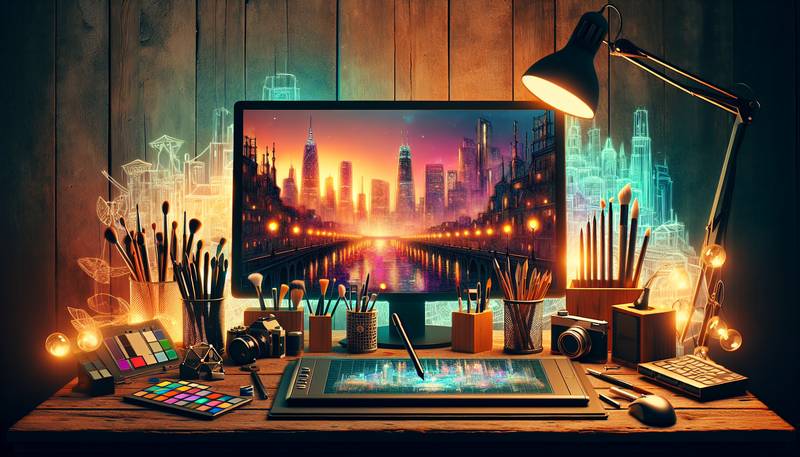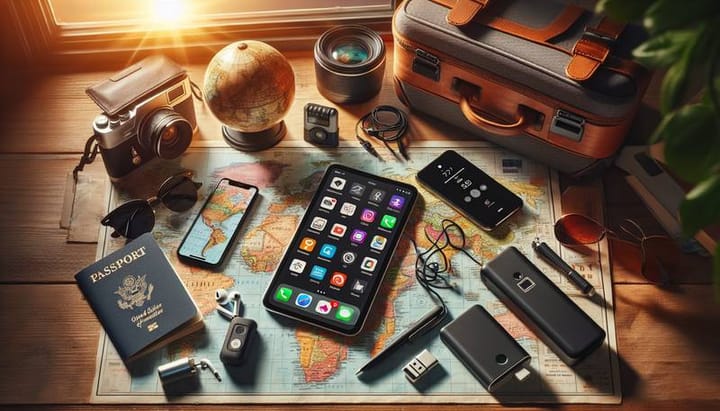Digital Art for Beginners: Tools, Software, and Tips

Introduction
Welcome to the vibrant and thrilling world of digital art! Whether you're transitioning from traditional mediums or diving into art creation for the first time, this guide is tailored for beginners looking to navigate the digital landscape. The shift to digital can feel overwhelming, but with the right preparation and understanding of the basic tools and software available, you'll soon be creating artwork that could rival any seasoned digital artist. Picture yourself crafting stunning illustrations, breathtaking graphic designs, or even animating characters that pop off the screen - it's all possible in the world of digital art. So, let's embark on this creative expedition together. Get ready to explore a plethora of artistic possibilities and unleash your inner digital Picasso!
Choosing the Right Tools
The foundation of any great digital artist is their toolkit. No masterpiece was ever created without the touch of a brush, digital or otherwise. The first and most vital tool you will need is a drawing tablet. Tablets come in various sizes and sensitivity levels, with some offering a screen for direct drawing, and others that connect to your monitor. When considering a tablet, think about the space you have and the kind of work you want to create. If you're a beginner, starting with an entry-level tablet might be the way to go. They're affordable, functional, and provide a great introduction to tablet drawing.
Alongside your tablet, you'll need a stylus. This is your digital pen, your chisel, your brush. A stylus usually comes with your tablet and is designed to work seamlessly with it, offering pressure sensitivity that mimics the feel of drawing on paper. Some styluses come with interchangeable tips, allowing you to simulate different drawing instruments. As you grow more confident in your skills, you may choose to invest in a more advanced stylus with additional features like tilt recognition and customizable buttons for a more efficient workflow.
Software Options for Digital Artists
Now that you have your tablet and stylus, it's time to talk software. The heart of digital art, the place where all your creative ideas will come to life. There is a myriad of art programs out there, each with its own set of tools, interfaces, and capabilities. Adobe Photoshop is one of the most renowned graphics editors and is favored for its extensive feature set, ideal for everything from photo editing to full-scale digital paintings. Its companion Adobe Illustrator is perfect for vector-based art, where you create designs that can scale infinitely without losing quality.
If you're looking for software that's a bit more wallet-friendly, check out Procreate for iPad users or Krita, a free and open-source alternative packed with features rivaling those of premium programs. For beginners, these platforms offer intuitive interfaces and robust communities where you can find tutorials and brushes shared by fellow artists. Remember, each artist has their own preference for software, so don't be afraid to try a few out. Most offer free trials, allowing you to get a feel for which suits your style best.
Getting Started with Digital Drawing
Imagine opening up your chosen software for the first time, a blank canvas awaits you. It can be exciting and a bit intimidating. Don't worry! Let's walk through the first steps of digital drawing together. Your software will have a 'new' document option - here you can choose the size and resolution for your artwork. If you're just practicing, something around 2000 pixels square at 300dpi (dots per inch) is a good starting point. This will give you enough detail for practice and is a nice size for sharing online.
Next, let's look at brushes. Your software will likely come with a selection of default brushes. Spend some time exploring these. See how they feel and what kind of marks they make. You can usually adjust their size, opacity, and hardness to change how they apply color. Experiment with each setting to understand how you might use them in your drawings. And don't forget, layers are your friend! They allow you to work on different parts of your artwork separately, without affecting the rest. It’s like having a stack of transparent papers, where you can draw a part of the image on each layer, allowing for intricate detail and easy corrections.
Now it’s time to get drawing. Start simple with line drawings and practice keeping your hand steady. Digital lines can feel different from drawing on paper, so give yourself time to adjust. Try tracing over photos or your traditional drawings to get a sense of how the stylus moves. Remember, undo is just a click away, so don't be afraid to make mistakes!
Stay tuned for the next sections where we'll cover creating polished artwork and joining the digital art community. Get ready to let your creativity soar!
Tips for Creating Stunning Digital Artwork
Creating digital art can seem daunting, but with a few insider tips, you'll be on your way to producing remarkable pieces. Composition is key, whether you're crafting a painting or designing a graphic. It's about how the elements of your piece are arranged and can make or break your work. Use guides and grids available in most digital art software to help you place objects and get proportions right. Also, learn about the 'Rule of Thirds,' a simple technique that suggests that dividing your canvas into a grid of nine equal parts and placing points of interest along the intersections makes a more pleasing composition.
Color theory is another essential topic to grasp. Colors evoke emotions and set the tone for your artwork. Understanding the color wheel and the relationships between colors will help you choose palettes that give your art life. Digital software gives you an advantage here, allowing you to experiment with color combinations easily and without waste.
Lighting and shading can add realism or drama to your art. Observe how light interacts with objects in the real world - where shadows fall, how light creates highlights, and how it affects colors. Then, translate that into your digital work. Remember to be consistent with your light source and use layers to experiment without ruining your base colors.
Practice Makes Perfect
Just as a musician practices their scales, an artist must refine their skills through regular practice. Set yourself small projects or challenges to keep building your abilities. This could be drawing a certain item every day for a week, trying new brushes, or even redecorating a photo to test your photo manipulation skills. The key is consistency – the more you practice, the more you'll improve. Your early work may not be perfect, but every piece is a step towards your mastery of digital art.
If you ever feel stuck, the internet is brimming with tutorials on every aspect of digital art. From beginner guides to in-depth process videos, there's an abundance of resources at your fingertips. And don't forget to save frequently! There's nothing more disheartening than losing hours of work to a software crash.
Joining the Digital Art Community
Art, at its core, is about expression and connection. Fortunately, the digital art community is vast and welcoming. Platforms like DeviantArt, ArtStation, and Behance allow you to showcase your work and get feedback from peers. Social media, especially Instagram and Twitter, are also great places to share your art and follow artists that inspire you.
Participate in community challenges like Inktober or 36 Days of Type. These not only give you a prompt to work with but expose your art to a wider audience. Forums and Discord channels can also be a treasure trove of advice and support, particularly for beginners.
Conclusion
Congratulations on taking the first steps on your digital art journey! Remember, every artist starts somewhere, and the path to becoming proficient in digital art is a marathon, not a sprint. With the right tools, appropriate software, and a steady practice routine, your potential for creating extraordinary digital artwork is limitless. Stay curious, be patient with your progress, and don't shy away from the fantastic community that awaits you.
So embrace the challenges, relish the learning experience, and most importantly, enjoy the process of bringing your unique vision to the world. Your digital canvas awaits, so boot up, log in, and start creating — your next masterpiece is just a stroke away!


